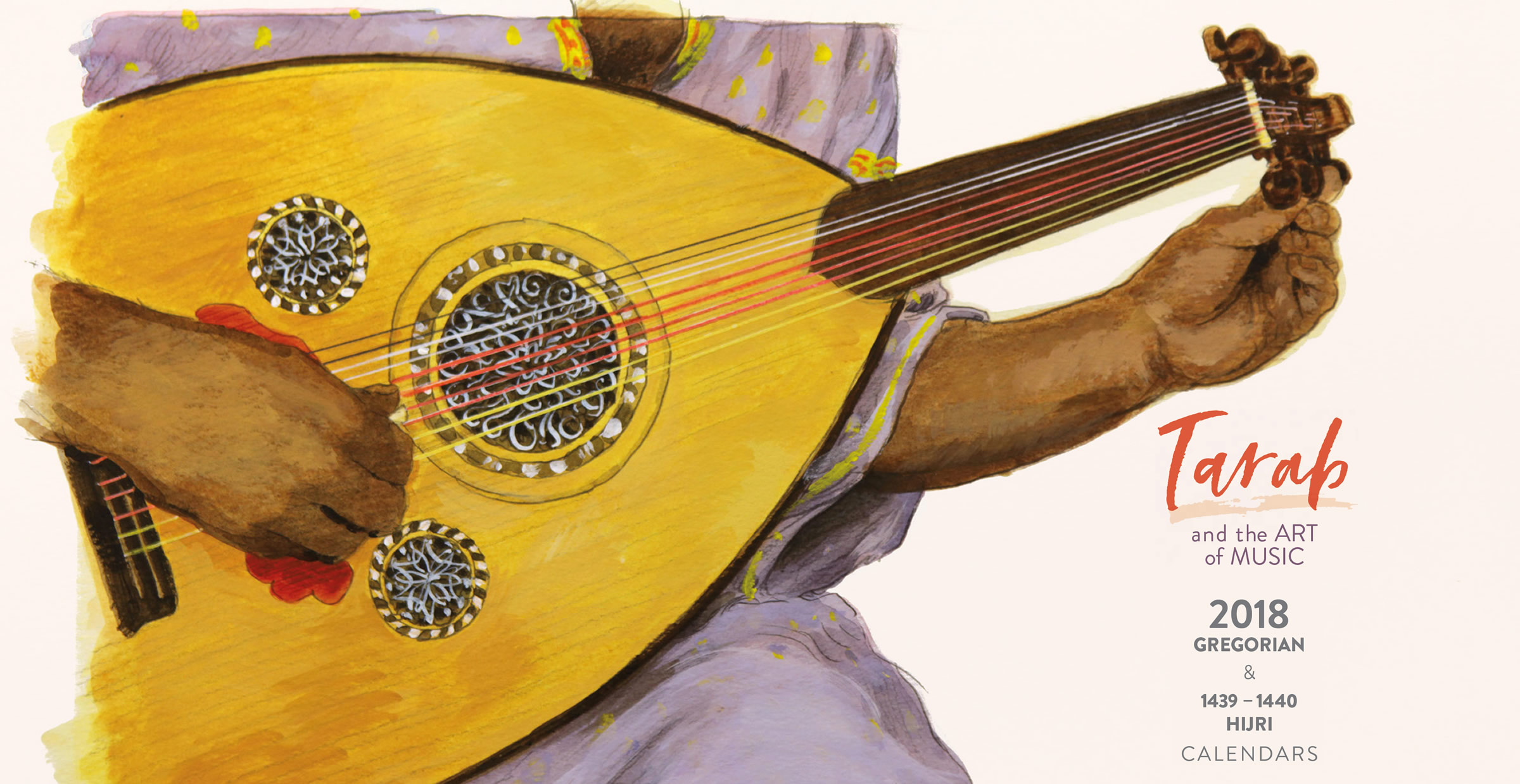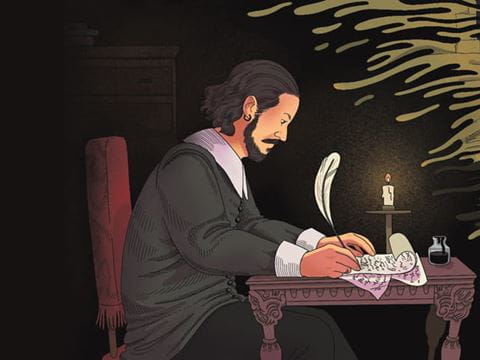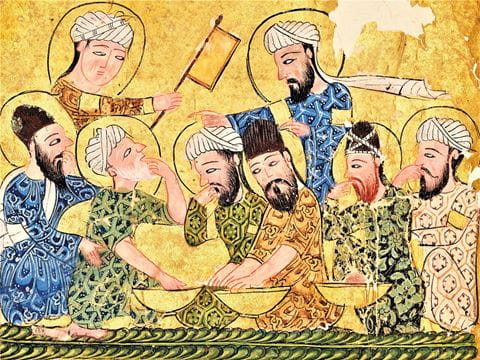Patterns of Moon, Patterns of Sun
Written by Paul Lunde
“It is he who made the sun to be a shining glory, and the moon to be a light (of beauty), and measured out stages for her, that ye might know the number of years and the count (of time).”
—Qur‘an 10:5 (English by Yusuf Ali)
The Hijri calendar
In 638 ce, six years after the death of the Prophet Muhammad, Islam’s second caliph, ‘Umar, recognized the necessity of a calendar to govern the affairs of Muslims. This was first of all a practical matter. Correspondence with military and civilian officials in the newly conquered lands had to be dated. But Persia used a different calendar from Syria, where the caliphate was based; Egypt used yet another. Each of these calendars had a different starting point, or epoch. The Sasanids, the ruling dynasty of Persia, used June 16, 632 ce, the date of the accession of the last Sasanid monarch, Yazdagird iii. Syria, which until the Muslim conquest was part of the Byzantine Empire, used a form of the Roman “Julian” calendar, with an epoch of October 1, 312 bce. Egypt used the Coptic calendar, with an epoch of August 29, 284 ce. Although all were solar calendars, and hence geared to the seasons and containing 365 days, each also had a different system for periodically adding days to compensate for the fact that the true length of the solar year is not 365 but 365.2422 days.
In pre-Islamic Arabia, various other systems of measuring time had been used. In South Arabia, some calendars apparently were lunar, while others were lunisolar, using months based on the phases of the moon but intercalating days outside the lunar cycle to synchronize the calendar with the seasons. On the eve of Islam, the Himyarites appear to have used a calendar based on the Julian form, but with an epoch of 110 bce. In central Arabia, the course of the year was charted by the position of the stars relative to the horizon at sunset or sunrise, dividing the ecliptic into 28 equal parts corresponding to the location of the moon on each successive night of the month. The names of the months in that calendar have continued in the Islamic calendar to this day and would seem to indicate that, before Islam, some sort of lunisolar calendar was in use, though it is not known to have had an epoch other than memorable local events.
There were two other reasons ‘Umar rejected existing solar calendars. The Qur’an, in Chapter 10, Verse 5, states that time should be reckoned by the moon. Not only that, calendars used by the Persians, Syrians and Egyptians were identified with other religions and cultures. He therefore decided to create a calendar specifically for the Muslim community. It would be lunar, and it would have 12 months, each with 29 or 30 days.
This gives the lunar year 354 days, 11 days fewer than the solar year. ‘Umar chose as the epoch for the new Muslim calendar the hijra, the emigration of the Prophet Muhammad and 70 Muslims from Makkah to Madinah, where Muslims first attained religious and political autonomy. The hijra thus occurred on 1 Muharram of the year 1 according to the Islamic calendar, which was named “hijri” after its epoch. (This date corresponds to July 16, 622 ce, on the Gregorian calendar.) Today in the West, it is customary, when writing hijri dates, to use the abbreviation ah, which stands for the Latin anno hegirae, “year of the hijra.”
Because the Islamic lunar calendar is 11 days shorter than the solar, it is therefore not synchronized to the seasons. Its festivals, which fall on the same days of the same lunar months each year, make the round of the seasons every 33 solar years. This 11-day difference between the lunar and the solar year accounts for the difficulty of converting dates from one system to the other.
The Gregorian calendar
The early Roman calendar was lunisolar, containing an average 355 days divided into 12 months. To keep it more or less in accord with the actual solar year, a month was added every two years. The system for doing so was complex, and cumulative errors gradually misaligned it with the seasons. By 46 bce, it was some three months out of alignment, and Julius Caesar oversaw its reform. Consulting Greek astronomers in Alexandria, he created a solar calendar in which one day was added to February every fourth year, effectively compensating for the solar year’s length of 365.2422 days. This Julian calendar was used throughout Europe until 1582 ce.
In the Middle Ages, the Christian liturgical calendar was grafted onto the Julian one, and the computation of lunar festivals like Easter, which falls on the first Sunday after the first full moon after the spring equinox, exercised some of the best minds in Christendom. The use of the epoch 1 ce dates from the sixth century, but did not become common until the 10th.
The Julian year was nonetheless 11 minutes and 14 seconds too long. By the early 16th century, due to the accumulated error, the spring equinox was falling on March 11 rather than where it should, on March 21. Copernicus, Christophorus Clavius and the physician Aloysius Lilius provided the calculations, and in 1582 Pope Gregory xiii ordered that Thursday, October 4, 1582, would be followed by Friday, October 15, 1582. Most Catholic countries accepted the new “Gregorian” calendar, but it was not adopted in England and the Americas until the 18th century. Its use is now almost universal worldwide. The Gregorian year is nonetheless 25.96 seconds ahead of the solar year, which by the year 4909 will add up to an extra day.
Converting years and Dates
The following equations convert roughly from Gregorian to hijri years and vice versa. However, the results can be slightly misleading: They tell you only the year in which the other calendar’s year begins. For example, 2018 Gregorian begins in Rabi’ II, the fourth month of hijri 1439, and it ends in that same month in hijri 1440.
Gregorian year =
[(32 x Hijri year) ÷ 33] + 622
Hijri year =
[(Gregorian year – 622) x 33] ÷ 32
Online calculators can be found by searching “Gregorian-hijri calendar calculator” or similar terms.
For more than a thousand years, performers, listeners and scholars have recognized tarab as one of the most important esthetics in Arab music.
It has no English equivalent, explains A.J. Racy, author of Making Music in the Arab World: The Culture and Artistry of Tarab. It is a term full of subtlety and layered meanings, both historical and regional. At its heart, tarab is about musical affect and relationship: a deep emotional response by a listener that leads to a feeling of connection between listener and performer. In this way, he says, tarab evokes “intense emotions, exaltation, a sense of yearning or absorption, feeling of timeless- ness, elation or rapturous delight.” In short, “ecstasy.”
Tarab appears to have come into use first in reference to early Arabic poetry recita- tion. After the seventh century ce, it came to be associated also with recitation of the Qur’an, which today endures as a highly popular virtuosic vocal art form. Music historian George Sawa notes more than 500 mentions of tarab in the Book of Songs, produced in Baghdad in the 11th century, including instances where listeners wept, laughed, danced and tore their clothing.
Far more recently, for decades during the mid-20th century across the Arab world, listeners would gather around radios on the first Thursday of each month to tune into live radio broadcasts of concerts by Um Kulthum, the famous Egyptian vocalist and mutriba—“one who elicits tarab.” Those lucky enough to be inside the Cairo concert hall often wept openly, shouted and begged her to repeat verses.
The tools of tarab are, of course, musical instruments, from the simplicity of the human voice and percussive hand clapping to hand drums, end-blown woodwinds and stringed instruments that are both plucked and bowed.
As Islam spread west and east, both instruments and musical ideas flowed along trade routes, and they were assimilated, adapted and often locally renamed. Even though the term “tarab” is used primarily in the Arab world, similar concepts are present from Morocco and Spain in the west to Malaysia in the east, and from Kazakhstan in the north to Somalia in the south. Notably these include haal in Persian music and duende in Spanish music.
Europe encountered Arab music through many routes, but perhaps most impor-tantly through the legacy of Ziryab, a ninth-century Baghdad émigré in al-An- dalus, now southern Spain. Arriving in Córdoba in 821 ce, he helped spark a flowering of music that today echoes in a Moroccan music style that some call Tarab Andalusi. Currently linguists dispute whether or not “tarab” is the root word for “troubadour.”
Beginning in the 1800s, Arab musicians assimilated Western instruments—primarily fretless, tonally versatile violins, violas, cellos and basses. It did not fundamentally affect the esthetic of tarab, and the best Arab and Arab-influenced musical performances, then as now, almost regardless of region or genre, remained nearly always highly inter- active events.
A resurgence of Arab music occurred in the early 20th century with independence. The advent of mass media and recording technology— including the flowering of now-classic Egyptian musical films—brought up the question, still argued, of whether or not a recording can elicit genuine tarab.
Today, as satellite and digital media allow the music from Arab and neighboring cultures to flow around the world at an unprecedented pace, tarab remains like a heartbeat, in the words of Syrian master musician Muhammad Qadri Dalal, “the connection between performers and audiences.”
TAQSIM and TARAB Ethnomusicologist Jonathan Shannon
Ethnomusicologist Jonathan Shannon notes that one particular way Arab musicians create tarab is by improvising outside rhythm or meter, and then returning to it. This improvisation is elemental to Arab music, and it is named taqsim in Arabic (pr. tahk-SEEM; plural taqasim). A musician can play a taqsim almost anywhere in a piece: at the beginning to introduce it, in the middle between verses or at any time players take turns playing solos.
In a taqsim, a musician creates a melody that explores a sophisticated network of modes or scales called maqamat (pr. mah-kah-MAHT; singular maqam). Many maqamat feature microtones, notes that occur between neighboring notes in Western scales. A great player must know how to play a wide, creative variety of taqasim within any given maqam, and how to transi- tion among several maqamat.
To end a taqsim, the performer must resolve it masterfully, often with a tarab-creating burst of energy that can be subtle and tender or expansive, even showy.





